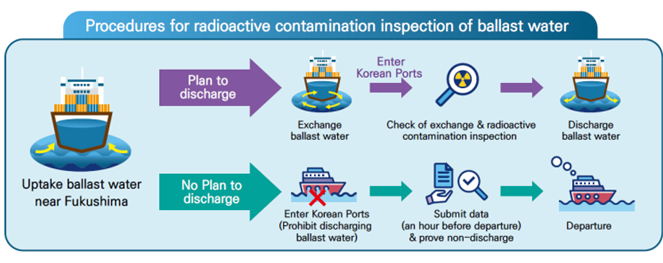News & Events
Related Pages
South Korea: Concerns on radioactive contamination lead to new ballast water requirements
Technical Newsletter as on 29th August 2023
Introduction
South Korea is adopting new measures on ballast water discharge following concerns arising from the discharge of treated wastewater from the Fukushima nuclear powerplant.
In order to prevent the inflow of possible radioactive ballast water into Korean waters a set of measures are to be implemented effective August 24, 2023, without exception on weekends, nights and holidays. Read more on the Spark International Bulletin.
Applicability & Requirements
Which vessels are subject to these new requirements?
Vessels that are entering the ports of Republic of Korea after up taking ballast water in the ports belonging to Aomori Prefecture, Iwate Prefecture, Fukushima Prefecture, Miyagi Prefecture, Ibaragi Prefecture and Chiba Prefecture in the eastern coast of Japan are all subject to the new ballast water requirements.
|
1st Requirement |
||
|
Situation/Vessel Plan |
Vessel Action Required |
Key Testing/Checks |
|
Vessels planning to enter Korean ports after taking on ballast water from six Eastern ports in Japan. (Aomori, Iwate, Fukushima, Miyagi, Ibaraki, Chiba). |
Submission of a ballast water reporting form* 24 hours prior to entering the Korean port. (*Including details related to the management of ballast water, such as the uptake, treatment, and discharge, etc.). There will be guidance from the local agents when they request for the vessel for the necessary documents for port clearance, and the details will be entered into PORT-MIS by the agent. |
Falsifying a ballast water reporting form or making a fraudulent entry in the BWMS operation record could lead to detention or fines for negligence in accordance with "Ballast Water Management Act." |
|
2nd Requirement |
||
|
Situation/Vessel Plan |
Vessel Action Required |
Key Testing/Checks |
|
Vessels planning to discharge ballast water in Korean waters after taking on ballast water from six Eastern prefectures in Japan. |
Exchange their Ballast water outside of Korean jurisdictional waters* before entering the Korean port. (*The exchange operation must take place between the passage of Tsugaru Strait and 135°30’E when sailing northward, such as passing Tsugaru Strait. When the vessel sails southward, such as through the Kanmon Strait, the exchange must be made between 34°35’N and 132°30’E.) |
The officers of Regional Maritime Affairs and Fisheries Office will carry out on-board inspection to check whether the Ballast water has been exchanged or not. They will take one (1) liter sample of ballast water and conduct a test to check radioactivity using mobile radioactive measuring equipment. This test will take about an hour. Discharge of ballast water will be allowed after passing the test.
If the Ballast water exchange has not been made, or if the test result is positive, the discharge of the Ballast water will be prohibited. |
|
3rd Requirement |
||
|
Situation/Vessel Plan |
Vessel Action Required |
Key Testing/Checks |
|
Vessels without a plan to discharge ballast water into Korean waters after taking on ballast water from six Eastern prefectures in Japan. |
Submit data proving non-discharge of ballast water to the person in charge of the relevant Regional Maritime Affairs and Fisheries Office via email at least an hour before departure. Documental proof includes the followings:
|
The relevant Regional Maritime Affairs and Fisheries Office will review the submitted documents to verify non-discharge status prior to departure (onboard investigation may be conducted if necessary). Vessel departure is only permitted following verification of ballast water status.
|

Please Note: Implementation of Requirements No. 1 and 2 of the above are generally no different from the requirements for reporting ballast water and replacing the water in the open sea, which are already required for all vessels prior to the release of treated wastewater from Fukushima nuclear plant. However, there is an addition to implementation of Requirement 2, which points out supplementary areas for the replacement of ballast water for vessels departing from six ports of eastern Japan.
Support from CTI-Maritec
Maritec provides a unique one-stop solution to meet your Discharge Water Compliance requirements (including Ballast Water, Oily Bilge Water, Scrubber Water & Gray Water) as per VGP 2013. Benefit from:
- Risk Mitigation: We help clients identify Testing Frequency for each vessel according to VGP requirements.
- Budget Control and Reduced Superintendent Workload: We help monitor the voyage to find the most economical ports for sampling/testing.
- Global Network: We offer testing worldwide for convenient sampling and reporting.
- Technical Support: We offer Audit & Crew Training and due-diligence support for vessel operational records review.
- Error Proof Processes: Ensures all layers of requirements are systematically before submission to EPA.
- Annual Report: EPA annual report preparation in EPA website on behalf of Clients
- Quick-response Times: Supports our customer queries on a real-time basis.
Get in touch
If you have any questions or comments please don't hesitate to contact us
Services
Fuel Testing Solutions Water Compliance Services IHM & Recycling Asbestos Management Solutions NDT&UTMContact Us
192 Pandan Loop,
#05-27 Pantech Business Hub,
Singapore 128381
T +65 6271 8622